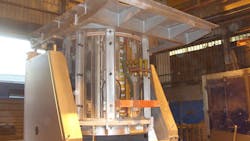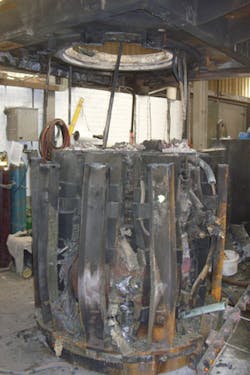Record-Setting Rebuild Has Foundry Melting Again
Imagine an explosion in a foundry melting process that rips through the plant, damaging all three furnaces, ancillary equipment, and the broader melt deck. That actually happened at an English foundry not long ago, and while it’s important to explain that no one was seriously injured, the destruction was presumed to be beyond repair, and appeared to be catastrophic for the foundry.
Yet, within 24 hours the foundry was melting again, and just about a month later everything was back in order. Melting activity had returned to full production.
The foundry managers acted quickly after the explosion. Once the fire was extinguished, a call went out for experts to assess the situation. They brought in engineers from Emsco, a part of the Inductotherm Group with operations in Sheffield, England, with electrical and mechanical engineers experienced in foundries, forge shops, and electrical processes for heavy industrial and power and distribution systems.
“We got a telephone call to say something was wrong with the furnaces,” recalled Emsco sales director John Green. That call couldn’t have prepared the engineers for the scene they encountered. “We found devastation, … but we defined the task and set about the job in hand. Our engineers cleaned and repaired the smaller furnace of the three in situ, which had been the furthest from the blast. This furnace was working again within 24 hours of the explosion.
“The second furnace was cleaned and rebuilt on site,” he continued, “and was working again within three days.”
The explosion occurred in a three-metric-ton furnace that suffered failure due to a bridge across molten charge. Of course, this was the vessel that suffered the most damage, and it would be written off by many. It was covered in solidified metal, and the cradle, coil, and assemblies were damaged to the point that nothing could be dismantled. The melting platform had to be cut away to extract the assembly as one complete lump, still encased in metal.
Taking it back to their workshop in Sheffield, the Emsco engineers assessed whether any of the parts might be salvaged. With time and financial constraints dictating the procedure, the foundry prepared itself for the bad news. Though the original expectation was that the furnace was beyond any repair, closer study allowed individual components to be identified and assessed.
Remarkably, once the task of stripping the furnace down had been completed the decision was made to rebuild. “Even though there were considerable man-hours required and new components, the cost of salvaging what we could and repairing the existing furnace was half the cost of a new one, and could be completed in less time than building a new furnace from scratch,” Green explained.
One of Emsco’s great advantages is its relationship with Inductotherm, resulting in the availability of parts at short notice. In this case, the accident had been so severe that the entire melting bay was re-commissioned by Inductotherm. (One casualty was the furnace steel cradle, which had to be scrapped and a new one manufactured.)
The induction coil was totalled, too; the distortion from the explosion had left it too large to be removed from the top, according to the furnace design. So, the coil and cradle were cut away and removed piece by piece.
A new coil was wound from the company’s stock of copper section and installed in to the new steel cradle assembly. Green explained. “Being able to draw on our own stock was critical,” he said. “Having to wait for a section would have seriously compromised delivery, extending it by some 12 weeks.”
The New Elements
All lamination shunts had to be built and installed, as the existing ones were unsalvageable. A new furnace base and top blocks also had to be made.
Of the salvaged parts, the only major components were the ‘A’ frames, which escaped the worst of the damage, and the hydraulic rams that, although requiring a full overhaul, were structurally intact.
While the rebuilding puzzle was underway at the Emsco works, engineers remained on site to oversee the restoration of all hydraulic, water, and power systems. This required new items like bus bars, water hoses, and water-cooled power leads to remake all the services and circuitries lost in the ensuing fires.
Despite the size of the task Emsco engineers worked 24/7 shifts to turn around what looked to be a nearly impossible job. Their determination and skill rebuilt the third furnace in record time, within four weeks. The engineers upheld the company’s reputation for keeping customers’ critical production furnaces running by drawing on its wide support network of engineers, experience, and stock levels.
“I hadn’t seen a furnace damaged this badly for many years, and I don’t believe there’s anyone else in Europe who could have taken this on and do it in the required timescale,” said Inductotherm Europe Ltd.’s managing director Steve Hill. “It’s worth noting that Emsco had plenty of other work on at the time, so for the engineers to be able to pull this one out of the bag is exceptional.”
As for the customer, they are “overjoyed,” John Green said. “The furnaces have been up and running for several months now, and have been given a new lease of life.”

